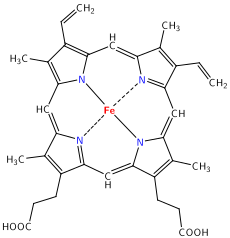User:Wc010394/sandbox
Tetrapyrroles are a class of chemical compounds whose molecules contain four pyrrole rings held together by direct covalent bonds or by one-carbon bridges (=(CH)- or -CH
2- units), in either a linear or a cyclic fashion. A pyrrole ring in a molecule is a five-atom heterocyclic compound where four of the ring atoms are carbon and one is nitrogen. In cyclic tetrapyrroles, deprotonation of the pyrrole rings allows for the chelation of metal ions through the lone electron pairs on nitrogen atoms facing the center of the macrocycle ring. These complexes typically bind metal ions such as iron, cobalt, or magnesium. The pyrrole rings, in relation to the metal ion center, are considered L-type ligands.
Tetrapyrroles exhibit a high degree of conjugation and aromaticity, and as a result absorb in the visible spectrum of electromagnetic radiation. Because of this chromophoric nature, these compounds are often referred to as biological pigments.[1]
Some tetrapyrroles are the active cores of some compounds with crucial biochemical roles in living systems, such as hemoglobin and chlorophyll. In these two molecules, in particular, the pyrrole macrocycle ring frames a metal atom, that forms a coordination compound with the pyrroles and plays a central role in the biochemical function of those molecules.
Completely aromatic macrocyclic tetrapyrrolic rings are referred to porphyrins, which are structurally composed of a 4 pyrrole skeleton linked together at the alpha positions by methine (=(CH)-) groups. Porphyrins are generally rigid and square planar[2], a structure resultant from their aromatic character.[3]
Structure
[edit]Linear tetrapyrroles (called bilanes) include:[4]
- Heme breakdown products (e.g., bilirubin, biliverdin)
- Phycobilins (found in cyanobacteria)
 |
 |

|
| Bilirubin | Biliverdin | Phycoerythrobilin |
Cyclic tetrapyrroles having four one-carbon bridges include:[5]
- Porphyrins, including heme, the core of hemoglobin
- Chlorins, including those at the core of chlorophyll.
Cyclic tetrapyrroles having three one-carbon bridges and one direct bond between the pyrroles include:
- Corrins, including the cores of cobalamins, when complexed with a cobalt ion.
 |
 |

|
| Heme group of hemoglobin | The chlorin section of the chlorophyll a molecule. The green box shows a group that varies between chlorophyll types. |
Cobalamin structure includes a corrin macrocycle. |
The tetrapyrrole portions of the molecules typically act as chromophores because of a high degree of conjugation in them. Therefore, these compounds are commonly colored.
Examples of Common Tetrapyrroles
[edit] |

|
| Chlorophyll a, a photosynthetic pigment | Heme, an integral cofactor for blood oxygenation |
Chlorophyll a is a common hydrophobic tetrapyrrole compound that chelates magnesium(II) in the pyrrole macrocycle ring. The chelation of magnesium alongside the high degree of conjugation of the compound allows for the absorption of light and the resonance energy transfer of electrons through the compound. As such, its function in biological systems is to undergo photooxidation by converting electromagnetic radiation in the form of photons into chemical energy in the form of electrons. In chloroplasts, chlorophyll a assists in the electron transfer for photosystems II and I. Light is absorbed by one tetrapyrrole and passed to another until it reaches a special chlorophyll a molecule known as P680 for photosystem II or P700 for photosystem I.[6] P680 and P700, named after their wavelength of maximum absorption, function as the direct electron donor the electron transport chain of the photosystems in photosynthesis.
Heme is a polyphyrin tetrapyrrole consisting of the 4 heterocyclic pyrrole rings in conjugated system that is chelated to a Fe(II) (ferrous) ion. The unique structure of heme allows for the binding of the generally unreactive oxygen diradical (O2). Heme functions as an oxygen carrier, binding O2 in regions of high concentration and releasing O2 in regions of low concentration. The ferrous ion in heme is bound equatorially by the four nitrogens in the pyrrole rings and as a result has 2 available axial position. In the myoglobin molecule, one of these axial positions is joined to a histidine residue.[7] Thus, there is still one available axial position for the reversible binding of oxygen.
Other ligands may also bind to the heme complex. CO and HCN, for example, can also occupy the axial ligand position of heme. These two molecules demonstrate a higher polarity than the oxygen diradical, and so bind irreversibly to the ferrous ion. This results in the depletion of available unbound heme, ultimately reducing the degree of oxygen transfer in biological tissues. This irreversible binding interaction is what causes the toxic nature of carbon monoxide and hydrogen cyanide.[8]
References
[edit]- ^ Biosynthesis of the Tetrapyrrole Pigment Precursor, a-Aminolevulinic Acid, from Glutamate1
- ^ http://www.ncbi.nlm.nih.gov/pmc/articles/PMC2839495/ Versatile supramolecular reactivity of zinc-tetra(4-pyridyl)porphyrin in crystalline solids: Polymeric grids with zinc dichloride and hydrogen-bonded networks with mellitic acid
- ^ http://www.ncbi.nlm.nih.gov/pubmed/21755961 Effects induced by axial ligands binding to tetrapyrrole-based aromatic metallomacrocycles.
- ^ Nomenclature of Tetrapyrroles, Appendix 1. Trivially named porphyrins, chlorins, chlorophylls and bilins, fundamental parents
- ^ Nomenclature of Tetrapyrroles, Appendix 1. Trivially named porphyrins, chlorins, chlorophylls and bilins, fundamental parents
- ^ http://www.ncbi.nlm.nih.gov/pmc/articles/PMC1069689/ The Light Reactions: A Guide to Recent Acquisitions for the Picture Gallery
- ^ http://www.ncbi.nlm.nih.gov/pubmed/8380334 Roles of proximal ligand in heme proteins: replacement of proximal histidine of human myoglobin with cysteine and tyrosine by site-directed mutagenesis as models for P-450, chloroperoxidase, and catalase.
- ^ http://www.ncbi.nlm.nih.gov/pubmed/12127991 Affinity of carbon monoxide to hemoglobin increases at low oxygen fractions.

